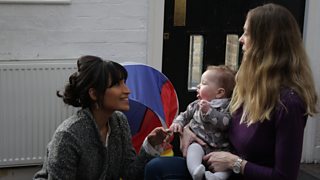What's the best way to soothe a crying baby?
The internet is filled with parents desperately looking for advice because their baby won’t stop crying. But the tips and techniques you find on the web are often conflicting – especially around the question of whether or not you should leave your baby to cry when trying to help them get to sleep.

We put some of the most popular theories to Dr Cathy Hill from Southampton University – a paediatrician and leading expert in children’s sleep.
Bedtime routine
Sleep training is not recommended until your baby is six months old, but from three months, parents can start to follow a regular routine around bedtime. This may include bathing, feeding, cuddling or reading. Once your child is getting drowsy, you could try putting them down in a cot and waiting in the bedroom while they settle, so they can start to learn the skills of self-soothing from an early stage.
Co-sleeping
Some parents favour sharing a bed with their baby – known as co-sleeping – but there’s evidence that sharing a bed with a baby under the age of 12 months increases the risk of Sudden Infant Death Syndrome, or “cot death”. So the advice is to keep your baby in the bedroom with you, but always in a crib or cot separate from your own bed.
Crying it out
At the opposite end of the spectrum, the idea of the “crying it out” approach is that the parent puts their baby to sleep in a safe place, leaves the room and allows them to cry until they fall asleep. It may be tough to listen to, but there is some evidence that this technique does help teach the child to settle on their own - meaning they’re less likely to wake up and need settling during the night.
Controlled crying
“Controlled crying”, also known as “controlled comforting”, is a more structured approach to the “crying it out” technique. Instead of leaving the child to cry indefinitely, the parent waits for a set period of time, after which they go back to the bedroom. This means that the child is reassured of the parent’s presence, and the parent is reassured that the child is safe. Gradually, the period of time can be extended until the child learns to fall asleep alone.
Recent literature reviews indicate that the controlled crying method is effective at improving children’s sleep. The vast majority of studies have found that children whose parents practised controlled crying settled more quickly and woke less often in the night.
Many parents may worry about the long-term psychological effects of leaving their child to cry. But large-scale studies in Australia, which followed groups of children up to the age of six, found that controlled crying had no effect on parent-child interaction, attachment, or behaviour compared to other sleep training techniques.
Crying is normal
Whatever approach you take, being consistent and establishing a routine is key to helping your baby learn to get themselves to sleep. But remember - it’s perfectly normal for babies to wake and cry at night, and it’s no reflection on your parenting skills!
Related Links













































































